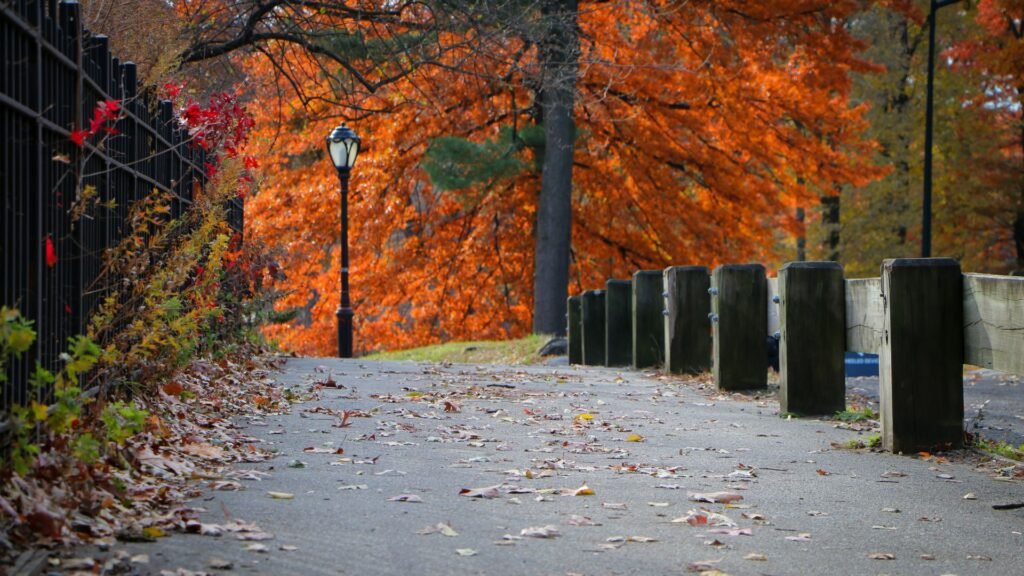Exploring NYC’s Central Park: A Nature Lover’s Guide Nestled in the heart of New York City, Central Park offers a breathtaking escape from the hustle and bustle of urban life. Spanning over 843 acres, the park is not just a green oasis but a hub of natural beauty, wildlife, and recreational opportunities. For nature lovers, Central Park is a paradise waiting to be explored. Whether you enjoy birdwatching, tranquil lakes, scenic gardens, or peaceful wooded trails, there’s something for everyone.
Here’s your nature lover’s guide to exploring the wonders of Central Park:
1. The Ramble: A Birdwatcher’s Paradise
For bird enthusiasts, The Ramble is the perfect spot. This 38-acre woodland is densely packed with trees, winding paths, and rocky outcroppings, making it a haven for over 230 bird species. Whether you’re an avid birder or a curious nature lover, bring your binoculars to catch glimpses of warblers, robins, woodpeckers, and hawks.
- Best time to visit: Spring and fall during the migratory seasons, when birds are most active.
- Pro tip: Visit early in the morning for the best chance to spot rare birds in a quieter environment.
2. Conservatory Garden: A Floral Wonderland
Located at Fifth Avenue and 105th Street, the Conservatory Garden is a six-acre floral sanctuary perfect for plant lovers and those seeking a peaceful retreat. The garden is divided into three distinct sections: the French-style North Garden, the Italianate Center Garden, and the English-style South Garden. Each section bursts with seasonal blooms, from tulips and lilacs in spring to chrysanthemums in the fall.
- Best time to visit: Spring and summer when the flowers are in full bloom.
- Pro tip: Spend time at the fountain in the center of the Italianate Garden for a serene spot to reflect and enjoy the view.
3. The Central Park Zoo: Connecting with Wildlife
Nature lovers, especially families, will delight in a visit to the Central Park Zoo. This 6.5-acre zoo houses over 150 species, including snow leopards, red pandas, and sea lions. The Tisch Children’s Zoo, adjacent to the main zoo, allows kids to interact with farm animals and learn about wildlife in a fun, engaging way.
- Best time to visit: Weekdays during the early morning or late afternoon to avoid large crowds.
- Pro tip: Don’t miss the sea lion feedings and the enchanting Tropic Zone, which simulates a rainforest habitat.
4. Rowing on The Lake: A Tranquil Experience
For a peaceful yet immersive experience in nature, rent a rowboat at Loeb Boathouse and take a leisurely paddle on The Lake. Surrounded by lush trees, this scenic waterway offers stunning views of the city skyline while keeping you enveloped in nature’s tranquility. You may also spot turtles, ducks, and other wildlife that frequent the lake.
- Best time to visit: Late spring through early fall when the weather is mild and the trees are lush.
- Pro tip: Plan a sunset rowing session for the most picturesque views as the golden hour light reflects on the water.
5. Shakespeare Garden: A Poet’s Natural Escape
Named after the famous playwright, Shakespeare Garden is a four-acre paradise filled with plants and flowers mentioned in Shakespeare’s plays. With winding paths, rustic benches, and an array of plants like primrose, foxglove, and thyme, this garden is perfect for poetry lovers and those seeking quiet contemplation amidst nature’s beauty.
- Best time to visit: Spring and summer for the fullest display of blooms.
- Pro tip: Stroll along the garden’s many pathways and read the bronze plaques that feature quotes from Shakespeare’s works.
6. Great Lawn: Perfect for Picnicking and Stargazing
Central Park’s Great Lawn is an iconic space for relaxation, picnicking, and even stargazing. This expansive 55-acre lawn is surrounded by trees and features open spaces where you can lay out a blanket and unwind. On summer evenings, it becomes a prime spot for stargazing, away from the glare of city lights.
- Best time to visit: Warm, clear evenings for a picnic under the stars.
- Pro tip: Visit during the summer for outdoor concerts and events like the New York Philharmonic’s free performances on the Great Lawn.
7. Belvedere Castle: Scenic Views and Wildlife Watching
Perched atop Vista Rock, Belvedere Castle offers some of the most scenic views in Central Park. From the castle’s terraces, you can enjoy sweeping views of Turtle Pond, The Great Lawn, and Delacorte Theater. Belvedere Castle is also a great spot for wildlife watching, especially turtles and migratory birds.
- Best time to visit: Anytime, but sunset provides particularly magical views.
- Pro tip: Bring binoculars or a camera with a zoom lens to get close-up views of wildlife and the park’s panoramic landscape.
8. The North Woods: A Quiet Woodland Escape
If you crave solitude and nature, head to the North Woods, one of the most tranquil and lesser-visited areas of Central Park. This area is filled with forested trails, waterfalls, and a peaceful atmosphere that feels far removed from the city. The woods are part of the park’s more naturalistic design, offering a woodland escape in the middle of Manhattan.
- Best time to visit: Autumn, when the leaves change color, turning the woods into a vibrant display of fall foliage.
- Pro tip: Explore The Loch and its waterfalls for a serene escape into nature.
9. The Central Park Reservoir: Scenic Walks and Jogging Path
For those who enjoy scenic walks or jogging, the Jacqueline Kennedy Onassis Reservoir is a must-visit. This 1.58-mile loop offers breathtaking views of the water, lined by cherry blossoms in the spring and framed by the Manhattan skyline. The wide, well-maintained path makes it perfect for a peaceful stroll or an energizing run.
- Best time to visit: Early morning for a serene atmosphere or springtime when cherry blossoms bloom.
- Pro tip: Take a camera along to capture the striking contrast between nature and the towering skyline.
10. Bethesda Terrace and Fountain: A Historic Masterpiece
Though popular, Bethesda Terrace and Fountain is a spot nature lovers shouldn’t miss. This iconic Central Park landmark is a masterpiece of 19th-century architecture, overlooking The Lake and framed by lush greenery. The area is a great place to relax after exploring the park’s natural gems or to sit and enjoy people-watching as musicians often perform here.
- Best time to visit: Anytime, but morning visits offer a quieter atmosphere.
- Pro tip: Visit in the fall for an unforgettable view of the autumn foliage reflecting in The Lake.
Conclusion
Central Park is a treasure trove for nature lovers, offering a blend of peaceful retreats, wildlife-rich areas, and scenic landscapes. Whether you’re looking to spend a quiet day birdwatching in The Ramble or enjoy a relaxing rowboat ride on The Lake, Central Park has endless opportunities to connect with nature amidst the vibrant energy of New York City.
Introduction to Central Park
Central Park, an iconic landmark located in the heart of New York City, serves as a verdant sanctuary amidst the urban complexity. Spanning over 843 acres, the park was meticulously designed by the eminent landscape architects Frederick Law Olmsted and Calvert Vaux, who envisioned it as a space where city dwellers could escape the hustle and bustle of metropolitan life. Their work aimed to create an accessible green oasis that would promote both relaxation and physical activity, reflecting the 19th-century ideals of improving public health and enhancing social interactions.
Since its opening in 1858, Central Park has evolved into not only a recreational hub but also a cherished cultural and historical icon. Its design incorporates naturalistic landscapes, including meandering pathways, sprawling lawns, serene lakes, and picturesque woodlands. These elements are carefully integrated to provide various ecosystems that support a diverse range of flora and fauna, making it an appealing destination for nature enthusiasts. The park’s landscapes offer visitors opportunities for leisurely strolls, picnics, and numerous outdoor activities, from boating to bird watching.
The significance of Central Park extends beyond its ecological features; it acts as a cultural centerpiece for the city, hosting numerous events, concerts, and art installations year-round. This blend of nature and culture attracts millions of visitors annually, highlighting the importance of green spaces in urban settings. Central Park exemplifies the transformative power of public parks and their role in fostering community connections, encouraging outdoor engagement, and providing a refuge for those seeking tranquility amidst the city’s vibrant atmosphere. As we delve deeper into the various facets of Central Park, it becomes evident why this greenery, enriched by history and purpose, holds a unique place in the hearts of both locals and tourists alike.
Getting to Know the Park’s Layout
Central Park, an iconic green oasis in the heart of Manhattan, stretches across 843 acres and is bordered by 59th Street to the south, 110th Street to the north, Central Park West to the west, and Fifth Avenue to the east. With numerous entrances, visitors can choose from several access points that lead into this expansive urban park. Key entrances include the entrance at 59th Street and 5th Avenue, often bustling with tourists, and the quieter entrances at 110th Street, which provide a more serene entry into nature.
Once inside the park, visitors will encounter various distinct areas, each offering unique experiences. One of the most visited spaces is the Great Lawn, a vast expanse of open grass that becomes a vibrant stage for sunbathers, picnickers, and sports enthusiasts alike. Adjacent to the Great Lawn is Bethesda Terrace, renowned for its stunning fountain and picturesque views of the surrounding area. This landmark serves not only as a meeting point but also as a hub of activity, often filled with street performers entertaining passersby.
Another key highlight is the Ramble, a beautifully landscaped woodland area comprising winding paths and hidden nooks perfect for nature enthusiasts seeking tranquility or birdwatchers hoping to catch a glimpse of migratory species. As visitors explore these areas, they will also discover notable features such as the Central Park Zoo, Strawberry Fields, and the picturesque Bow Bridge, all contributing to the park’s rich tapestry of natural beauty and historical significance.
Detailed maps of Central Park are readily available, guiding explorers through its myriad trails and ensuring they do not miss out on any of the park’s breathtaking spots. By familiarizing themselves with the park’s layout, visitors can successfully navigate its vast landscape, creating memorable experiences in one of New York City’s most treasured landmarks.
Flora and Fauna of Central Park
Central Park serves as a vital green oasis amidst the urban landscape of New York City, showcasing a rich diversity of flora and fauna. The park is home to over 25,000 trees, many of which are native species contributing to the city’s ecological health. Notable species include the majestic oak, sweetgum, and sugar maple, each playing a crucial role in supporting local wildlife. The seasonal changes in this verdant environment provide an ever-evolving backdrop, offering visitors a chance to observe the park’s dynamic ecosystems at different times of the year.
The Conservatory Garden, a formal garden within Central Park, is divided into three distinct styles: Italian, French, and English. This area features meticulously planned plantings, seasonal blooms, and ornamental shrubs, attracting a plethora of pollinators such as butterflies and bees. Visitors can immerse themselves in this vibrant sanctuary, exploring the intricate pathways lined with stunning flowers and greenery. Similarly, the Children’s Glade, a more naturalistic area, boasts various native plants that provide essential habitats for bird species, including warblers and sparrows, enriching the biodiversity within the park.
Additionally, Central Park’s diverse habitats, ranging from meadows to woodlands, create significant environments for various wildlife. Birdwatchers flock to the park to witness the migratory patterns of over 200 species that pass through annually. Seasonal migration events transform the park into a kaleidoscope of avian activity. Maintaining these ecosystems is paramount for their conservation, as they are increasingly threatened by urban development and climate change. Understanding the importance of these natural areas and participating in preservation initiatives can help safeguard the park’s biodiversity for future generations.
Must-Visit Natural Attractions
Central Park, a renowned urban oasis in New York City, offers an extensive array of natural attractions that draw nature lovers from around the globe. Among its many delights, Bow Bridge stands out as one of the most iconic structures within the park. This beautiful cast-iron bridge, completed in 1862, features stunning Gothic Revival architecture and provides a picturesque view of the surrounding landscapes. It is an ideal spot for photography enthusiasts, especially during sunset when the light casts a magical glow over the waters of the lake below.
Another captivating area worth exploring is the Ramble, a woodland section teeming with winding trails, serene ponds, and an impressive variety of flora and fauna. Spanning 36 acres, the Ramble was designed to mimic the natural landscapes of the Hudson Valley, presenting visitors with a tranquil escape from the bustling city. The labyrinthine paths are perfect for leisurely strolls or birdwatching, as this area is one of the best places to observe migratory birds in the heart of Manhattan. Engaging with the immersive natural environment is a memorable experience for every visitor.
Additionally, the picturesque Lake is a focal point of Central Park, offering recreational opportunities for canoeing, kayaking, and picnicking along its banks. This 20-acre body of water serves as a habitat for an array of wildlife, including turtles, ducks, and various fish species. Renting a rowboat in the warmer months provides a delightful way to experience the park from a unique vantage point. Whether one chooses to relax with a good book, capture stunning photographs, or simply observe the diverse wildlife, the Lake is an essential destination for nature lovers visiting Central Park.
Outdoor Activities for Nature Lovers
Central Park, a verdant oasis in the heart of New York City, offers a plethora of outdoor activities for those who cherish nature. Walking and biking are among the most popular ways to explore its expansive 843 acres. The park boasts a network of scenic trails and roads, enabling visitors to immerse themselves in the stunning landscapes that change with each season. For a leisurely experience, the 6-mile loop around the park provides an ideal path for both walkers and cyclists, ensuring an enjoyable outing that connects individuals with Central Park’s natural beauty.
For birdwatching enthusiasts, Central Park is a prime location, particularly during spring and fall migrations. Birdwatchers can delight in spotting a variety of species, including warblers, thrushes, and sparrows. The park organizes guided birdwatching events led by knowledgeable experts, providing insight into local avian life. Alternatively, self-guided exploration can be undertaken; the Ramble and the North Woods are excellent areas for observing birds in their natural habitat. Bringing binoculars can enhance the birdwatching experience, allowing enthusiasts to observe these beautiful creatures at a closer range.
Yoga has also found a welcoming home in Central Park, with many enthusiasts gathering in serene locations such as the Great Lawn or near the tranquil waters of the Jacqueline Kennedy Onassis Reservoir. Various classes are offered throughout the warmer months, allowing participants to practice mindfulness while surrounded by the park’s lush environment. For those who prefer self-guided sessions, mornings or late afternoons are generally the best times to enjoy peaceful yoga sessions amidst nature’s beauty.
Equipping oneself with proper gear, whether for biking, birdwatching, or yoga, is essential for a fulfilling experience in Central Park. Comfortable shoes are a must for walking or biking, while binoculars and field guides enhance birdwatching adventures. Yoga mats are also recommended for those who wish to join or initiate outdoor classes. Ultimately, Central Park not only nurtures the love for nature but also provides endless opportunities to engage with it actively.
Seasonal Changes and Their Beauty
Central Park is a remarkable sanctuary that showcases nature’s transformative beauty throughout the seasons. Each time of year brings its own unique palette and opportunities for exploration, making it a haven for nature lovers all year round. In spring, Central Park comes alive as flowers begin to bloom, painting the landscape with vibrant colors. Cherry blossoms, tulips, and hyacinths create a stunning visual display, drawing visitors to iconic locations such as the Conservatory Garden and the Bethesda Terrace. This season is perfect for leisurely strolls and picnics amidst the fragrant blossoms.
As spring transitions into summer, the park transforms into a lush green oasis. The trees are full and provide ample shade, making it an ideal time for outdoor activities. Summer enthusiasts can enjoy paddle boating at the Loeb Boathouse or outdoor concerts on the Great Lawn. The park’s many shaded pathways are perfect for walking, jogging, or cycling, offering a cooling retreat from the city heat.
Fall is perhaps one of the most breathtaking seasons in Central Park, as the leaves turn brilliant shades of red, orange, and yellow. The changing foliage attracts photographers and nature enthusiasts alike, with popular viewing spots including The Mall and Bow Bridge. This season also offers the annual Central Park Harvest Festival, showcasing local produce and festivities that celebrate the bounty of autumn.
In winter, Central Park takes on a serene and magical quality. Snow blankets the landscape, transforming it into a winter wonderland. Activities such as ice skating at Wollman Rink and winter hiking are popular among visitors looking to enjoy the park’s quiet beauty. The barren trees juxtaposed against the white snow create picturesque views, particularly around the iconic bridges and open meadows. Each seasonal change in Central Park provides a distinctive allure, encouraging everyone to embrace its splendor throughout the year.
Central Park’s Hidden Gems
While Central Park is well-known for its iconic landmarks such as Bethesda Terrace and the Great Lawn, it also houses a multitude of hidden gems that promise serene experiences away from the bustling crowds. One such spot is the Secret Garden, tucked away near the Conservatory Garden. This tranquil area features beautifully manicured lawns, vibrant seasonal blooms, and secluded benches where visitors can unwind and appreciate the art of nature in peace. The intimate setting of the Secret Garden makes it an ideal retreat for those seeking solitude.
Another noteworthy location is the Ramble, a woodland area designed to resemble a natural forest. This sprawling terrain includes winding trails, rocky paths, and a variety of ponds, all contributing to the charm of this hidden enclave. As you wander through the Ramble, you may encounter an array of bird species, making it a popular spot for birdwatching enthusiasts. The ambient sounds of rustling leaves and gentle water streams offer an immersive experience, allowing visitors to connect deeply with nature.
For those interested in art and history, Belvedere Castle serves as a remarkable vantage point yet often goes unnoticed. It offers stunning views of the surrounding landscape and houses a visitor center that hosts educational programs about the park’s natural history. Nearby, the Delacorte Theater is another gem, hosting free Shakespeare performances during the summer months. Exploring these lesser-known locations not only enhances one’s Central Park experience but also encourages a greater appreciation for the peaceful pockets of wilderness within an urban setting.
These hidden treasures remind visitors of the tranquil beauty Central Park has to offer beyond the crowded attractions. They invite exploration and foster a deeper connection with nature, making your visit to Central Park unforgettable.
Preserving Nature in Central Park: Efforts and Initiatives
Central Park is not only an urban oasis but also a vital ecosystem that houses a diverse range of flora and fauna. The conservation of this natural beauty requires concerted efforts from various stakeholders, including non-profit organizations, community groups, and individual volunteers. Numerous initiatives are in place to ensure that the park’s biodiversity is preserved for both present and future generations.
Organizations such as the Central Park Conservancy play a pivotal role in the park’s maintenance and conservation. This non-profit organization is deeply committed to restoring and enhancing the park’s landscapes while advocating for sustainable practices. Through fundraising, education programs, and community outreach, the Conservancy works diligently to preserve Central Park’s ecological integrity. Their initiatives extend beyond maintenance to include wildlife monitoring, reforestation projects, and invasive species management, ensuring that the park remains a thriving habitat.
In addition to institutional efforts, there are ample volunteer opportunities for individuals wishing to contribute to the park’s conservation. Volunteer days often involve tree planting, planting native species, and participating in clean-up efforts. Engaging in these activities not only benefits the environment but also fosters a sense of community among participants. Visitors can check the Central Park Conservancy’s website for upcoming volunteer events, which provide an excellent platform to give back to this iconic site.
Community involvement is crucial for the sustained health of Central Park’s ecosystem. Engaging local residents and park users promotes environmental awareness and stewardship. Residents often initiate local clean-up days, educate others about native wildlife, and advocate for sustainable policies affecting urban green spaces. By working collaboratively, both organizations and individuals can make a meaningful difference in preserving Central Park’s natural beauty.
Each effort, whether large or small, contributes towards maintaining the scenic landscapes and rich biodiversity that define Central Park. By participating in these initiatives, visitors not only enrich their own experience but also partake in the ongoing efforts to protect this cherished public park.
Planning Your Visit: Tips and Recommendations
Visiting Central Park is an enriching experience that offers a blend of nature, culture, and recreational activities. To make the most of your visit, proper planning is essential. The best times to explore Central Park are during the early mornings or late afternoons, particularly in spring and autumn when the weather is mild and the foliage is at its most vibrant. Weekdays tend to be less crowded than weekends, allowing for a more serene experience.
When preparing for your excursion, packing essential items will enhance your adventure. Comfortable walking shoes are a must, as exploring the park often requires significant walking. Furthermore, bringing along a reusable water bottle will help you stay hydrated while minimizing single-use plastic waste. Don’t forget to pack sunscreen and a light jacket, as temperatures can change throughout the day. If you plan to enjoy a picnic, consider including a blanket and some snacks to savor in one of the many picturesque spots.
Several amenities are conveniently located near the park. Numerous cafes and food vendors are scattered throughout Central Park, providing a range of dining options, from quick snacks to leisurely meals. Facilities such as restrooms are also available at various locations, ensuring that visitors have access to necessary conveniences. Additionally, specialty food trucks offer a diverse array of choices for those looking to sample different cuisines.
Accessibility is a key consideration for any visitor. Central Park is committed to ensuring that everyone can appreciate its beauty. Many paths and attractions are wheelchair accessible, and there are designated accessible parking spots nearby. For those needing additional assistance, wheelchairs are available for rent, enhancing the ability of all nature lovers to explore the park’s wide range of features and activities.
By thoughtfully considering these aspects of your visit, you can ensure a memorable experience that allows you to fully enjoy the natural beauty Central Park has to offer.













